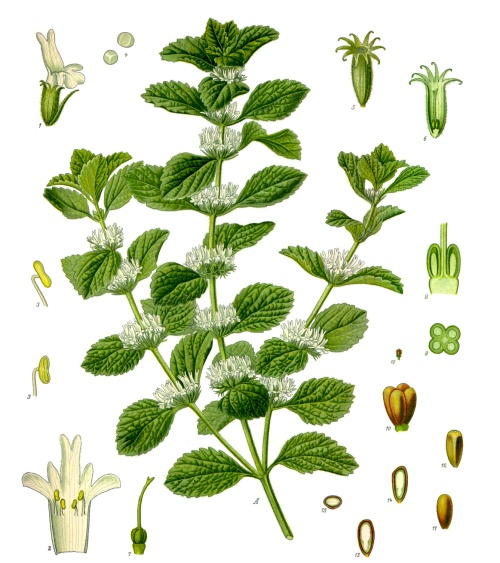
Marrubium vulgare (L)
Synonyms and Common names: Harhound, Hoarhound, common hoarhound
German = Maurerandorn, French = Marrube blanc, Italian = Marrobio bianco,
Spanish = Marrubio
Order: Labiatae
Description: Marrubium is an erect mint-like plant, indigenous to Britain and widely distributed over Europe, central and northern Asia, and scattered throughout North America. It is densely covered in white fur, has a thick stem, and grows up to 60cm. The circular to broadly ovate wrinkled leaves, 15-40mm long, are bluntly toothed at the margins. The upper surface is greyish and less hairy than the lower surface. Dense whorls of off-white flowers, about 15mm long, are found in the axils of paired, leaf-like bracts The calyx tube has ten tiny hooked teeth at the rim. Marrubium flowers between April and October and inhabits roadsides and waste places.
Parts used: Dried leaves and flowering tops
Collection: During the flowering period between June and September.
Constituents: Sesquiterpene bitters (including marrubiin), Diterpene alcohols (marrubenol, marrubiol, peregrinol, vulgarol, phytol), flavonoids (apigenin, luteolin), small amounts of pyrrolidine alkaloids (betonicine, stachydrine), traces of volatile oil (containing alpha-pinene, sabine, camphene and p-cymol), alkaloids, ursolic and caffeic acid, tannins, saponin, mucilage, minerals (especially potassium), vitamin C, resins, wax, sterols
Actions: Gentle stimulating expectorant, gentle circulatory stimulant, relaxant, antispasmodic, antiseptic, bitter digestive and hepatic tonic, soothing tonic for the mucous membranes, vulnerary
Indications: acute or chronic bronchitis, whooping cough, catarrh of the respiratory tract, anorexia, dyspepsia. Specifically indicated in bronchitis with a non-productive cough.
Therapeutics and Pharmacology: Marrubium is indicated in bronchitis and chest colds, particularly congestive catarrhal conditions with a non-productive cough. It has also been used to treat whooping cough. Its action is to relax the smooth muscles of the bronchi whilst promoting mucus production and expectoration. The expectorant action, caused by the stimulation of mucus secretion by the lining of the respiratory tract, is attributed to marrubiin and to the volatile oil. A hot infusion of Marrubium has a diaphoretic action, and it has been used in the past to reduce malarial fever..
The cold infusion is a bitter tonic to the digestive system. The sesquiterpene bitters, marrubiin and premarrubiin, stimulate the flow of saliva and gastric juices, thereby stimulating the appetite. As marrubiin breaks down in the gut, it stimulates the secretion and flow of bile, thus aiding digestion.
Marrubium has a traditional reputation for calming a nervous heart. In small amounts, marrubiin exhibits a normalising effect on irregular heartbeats, although high doses may cause arrhythmias. The volatile oil helps to dilate the arteries.
Combinations: Marrubium combines well with Cephaelis, Tussilago and Lobelia in bronchitic conditions, and it may be used with Zingiber in whooping cough.
Caution: No contraindications are known, but very large doses are purgative. It should be avoided during pregnancy and lactation.
Preparation and Dosage: (thrice daily)
GSL Schedule 1
Dried herb: 1-2g or by infusion
Liquid Extract: 1:1 in 20% alcohol, 1-2ml
Tincture: 1:5 in 25% alcohol, 3-6ml
Horehound Syrup BPC (1949), 2-4ml
Additional Comments: One of the oldest and most reliable cough remedies known, White Horehound has been used since the time of the Egyptian pharaohs. It is one of the bitter herbs ordained to be eaten at Passover supper by the Jews (the Hebrew word marrob means 'bitter juice'). Gerard recommended it for the bites of serpents and mad dogs. The Navajo give mothers a decoction of the root before and after childbirth.
Bibliography
Bartram, T. 1995 Encyclopaedia of Herbal Medicine, 1st edn., Grace Publishers, Bournemouth.
Bradley, P.R. (ed.) 1992 British Herbal Compendium, Volume 1, BHMA, Bournemouth.
Bremness, L. 1994 Herbs, Dorling Kindersley Eyewitness Handbook, London.
BHMA 1983 British Herbal Pharmacopoeia, BHMA, Bournemouth.
Chevallier, A. 1996 The Encyclopaedia of Medicinal Plants, Dorling Kindersley, London.
Grieve, M. 1931 A Modern Herbal, (ed. C.F. Leyel 1985), London.
Hoffmann, D. 1990 The New Holistic Herbal, Second Edition, Element, Shaftesbury.
Lust, J. 1990 The Herb Book, Bantam, London.
Mabey, R. (ed.) 1991 The Complete New Herbal, Penguin, London.
Mills, S.Y. 1993 The A-Z of Modern Herbalism, Diamond Books, London.
Newall, C.A., Anderson, L.A., & Phillipson, J.D. 1996 Herbal Medicines: A Guide for Health-care Professionals, The Pharmaceutical Press, London.
Ody, P. 1993 The Herb Society's Complete Medicinal Herbal, Dorling Kindersley, London.
Polunin, M. and Robbins, C. 1992 The Natural Pharmacy, Dorling Kindersley, London.
Press, B. & Gibbons, B. 1993 Wild Flowers of Britain and Europe: Photographic Field Guide, New Holland Publishers, London.
Wren, R.C. 1988 Potter's New Cyclopaedia of Botanical Drugs and Preparations, C.W.Daniel, Saffron Walden.










